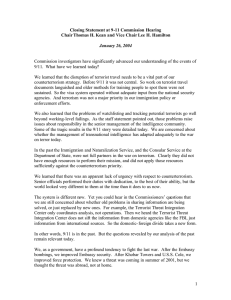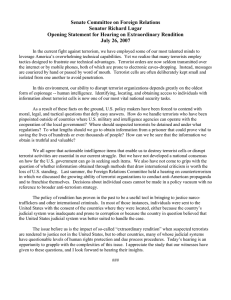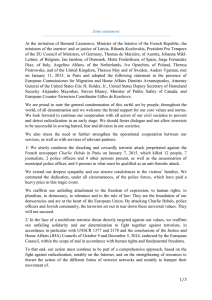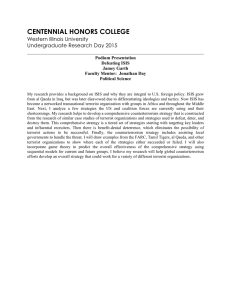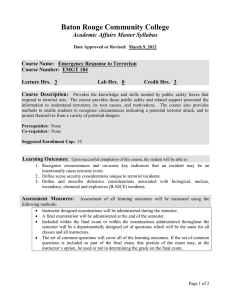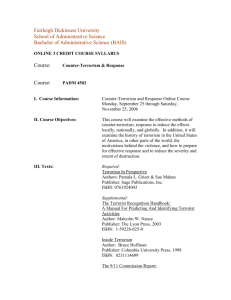INFRASTRUCTURE, SAFETY, AND ENVIRONMENT 6 The RAND Corporation is a nonprofit research
advertisement
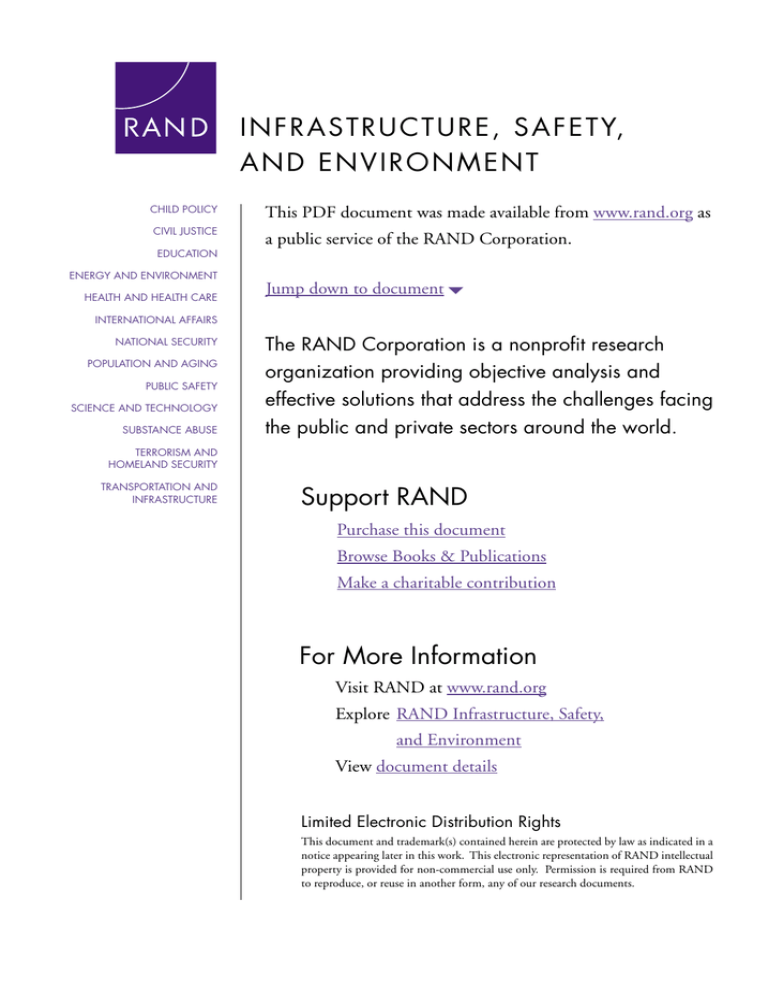
I N F RA S TR UCTURE, SA FETY, A N D EN V IRON MEN T CHILD POLICY CIVIL JUSTICE EDUCATION ENERGY AND ENVIRONMENT HEALTH AND HEALTH CARE This PDF document was made available from www.rand.org as a public service of the RAND Corporation. Jump down to document6 INTERNATIONAL AFFAIRS NATIONAL SECURITY POPULATION AND AGING PUBLIC SAFETY SCIENCE AND TECHNOLOGY SUBSTANCE ABUSE The RAND Corporation is a nonprofit research organization providing objective analysis and effective solutions that address the challenges facing the public and private sectors around the world. TERRORISM AND HOMELAND SECURITY TRANSPORTATION AND INFRASTRUCTURE Support RAND Purchase this document Browse Books & Publications Make a charitable contribution For More Information Visit RAND at www.rand.org Explore RAND Infrastructure, Safety, and Environment View document details Limited Electronic Distribution Rights This document and trademark(s) contained herein are protected by law as indicated in a notice appearing later in this work. This electronic representation of RAND intellectual property is provided for non-commercial use only. Permission is required from RAND to reproduce, or reuse in another form, any of our research documents. This product is part of the RAND Corporation monograph series. RAND monographs present major research findings that address the challenges facing the public and private sectors. All RAND monographs undergo rigorous peer review to ensure high standards for research quality and objectivity. Aptitude for Destruction Volume 1 Organizational Learning in Terrorist Groups and Its Implications for Combating Terrorism Brian A. Jackson with: John C. Baker Kim Cragin John Parachini Horacio R. Trujillo Peter Chalk Prepared for the National Institute of Justice The research described in this report was supported by Grant No. 2003IJ-CX-1022 awarded by the National Institute of Justice, Office of Justice Programs, U.S. Department of Justice. The research was conducted within RAND Infrastructure, Safety, and Environment (ISE), a division of the RAND Corporation, for the National Institute of Justice. Points of view in this document are those of the authors and do not necessarily represent the official position or policies of the U.S. Department of Justice. Library of Congress Cataloging-in-Publication Data Aptitude for destruction : organizational learning in terrorist groups and its implications for combating terrorism / Brian A. Jackson ... [et al.]. p. cm. “MG-331.” Includes bibliographical references. ISBN 0-8330-3764-1 (pbk. : alk. paper) 1. Terrorists. 2. Organizational learning. 3. Terrorism—Prevention—Government policy. I. Jackson, Brian A. (Brian Anthony) II.Title. HV6431.A67 2005 303.6'25—dc22 2005003983 Photo courtesy of iStockphoto.com Inc. Copyright 2005 iStockphoto Inc. Online at http://www.iStockphoto.com The RAND Corporation is a nonprofit research organization providing objective analysis and effective solutions that address the challenges facing the public and private sectors around the world. RAND’s publications do not necessarily reflect the opinions of its research clients and sponsors. R® is a registered trademark. Cover design by Stephen Bloodsworth © Copyright 2005 RAND Corporation All rights reserved. No part of this book may be reproduced in any form by any electronic or mechanical means (including photocopying, recording, or information storage and retrieval) without permission in writing from RAND. Published 2005 by the RAND Corporation 1776 Main Street, P.O. Box 2138, Santa Monica, CA 90407-2138 1200 South Hayes Street, Arlington, VA 22202-5050 201 North Craig Street, Suite 202, Pittsburgh, PA 15213-1516 RAND URL: http://www.rand.org/ To order RAND documents or to obtain additional information, contact Distribution Services: Telephone: (310) 451-7002; Fax: (310) 451-6915; Email: order@rand.org Summary If a terrorist group lacks the ability to learn, its effectiveness in achieving its goals will largely be determined by chance—the chance that its members already have the necessary skills to carry out operations and support activities; the chance that its current tactics are effective against desirable targets and against current antiterrorism measures; and the chance that shifts made by the group will prove to be beneficial.1 Similarly, in a dynamic environment, a terrorist organization that cannot learn will not be able to effectively adapt to new developments in intelligence gathering and law enforcement. But when a terrorist group can learn—and learn well—it can act systematically to fulfill its needs, strengthen its capabilities, and advance its strategic agenda. The ability to learn allows a terrorist group to purposefully adapt to ever-evolving circumstances by • Developing, improving, and employing new weapons or tactics that can enable it to change its capabilities over time • Improving its members’ skills in applying current weapons or tactics • Collecting and utilizing the intelligence information needed to mount operations effectively • Thwarting countermeasures and improve its chance of surviving attempts to destroy it • Preserving the capabilities it has developed even if some of its members are lost ____________ 1 While change in the way a group carries out its activities is frequently indicative of learning, the occurrence of change is not sufficient to indicate that organizational learning has occurred. Changes are not necessarily intentional; they can be made unintentionally or for exogenous reasons incidental to the behavior that is changed (e.g., a change may occur in one area simply as a result of a change made in another). In this study, we define learning as sustained changes that involve intentional action by or within a group at some point—such as one or more of the following: intentional seeking of new knowledge or new ways or doing things; intentional evaluation of behaviors, new or old, that leads to efforts to retain valuable behaviors and discard others; and/or intentional dissemination of knowledge within a group or among groups when such knowledge is deemed useful or beneficial. Furthermore, we categorize as learning only changes that are beneficial to the terrorist group. ix x Aptitude for Destruction A terrorist group’s ability to learn is therefore a primary determinant of the level of threat it poses, since learning is the route through which organizations can seek solutions to the problems that bound their freedom of action and limit their ability to pursue their goals in changing operational and security circumstances. The Need to Understand Organizational Learning Discerning how terrorist groups learn in a dynamic environment is crucial for understanding terrorism. With increased understanding of group learning processes, intelligence analysts and security planners will be better able to • Assess the level of threat posed by a terrorist organization, which can be radically altered by effective learning. • Design and implement strategies for combating terrorism, using knowledge of how terrorist groups use learning to blunt or overcome the countermeasures and security systems intended to defeat their efforts. • Appropriately allocate resources for combating terrorism, since terrorist groups that can learn effectively can pose a more potent threat than do organizations that are unable to change and adapt. An understanding of terrorist group learning can also assist in developing metrics for efforts to combat terrorism by providing an additional approach for assessing the effects of countermeasures on terrorist group capabilities. About This Study This study addresses two basic questions: • What is known about how terrorist groups learn? • Can such knowledge be used by law enforcement and intelligence personnel in their efforts to combat terrorism? To answer these questions, we have (1) examined theory and data about how organizations learn, drawn from the organizational behavior and management literature, and (2) developed in-depth case studies of learning in a variety of terrorist Summary xi groups through literature research and interviews with intelligence and law enforcement professionals who have had direct experience with terrorist groups.2 Using analytical frameworks drawn from the organizational-theory literature to assist in framing questions about what organizations must do to learn, we examined terrorist groups that have been successful learners in order to focus on those behaviors of greatest concern. Discussions with intelligence and law enforcement professionals enabled us to explore the applicability and utility of organizational-learningfocused approaches to analysis and operational planning for combating terrorism. Figure S.1 Component Processes of Organizational Learning Information or knowledge acquisition Interpretation Storage Distribution RAND MG331-S.1 Terrorist groups present a moving target that can prove very difficult to hit. Effective efforts to combat terrorism require the ability to anticipate how and where groups are evolving over time. Beyond simply describing how such groups change— for example, tracking differences in weapons they use or how well they use them—we need to understand the mechanisms through which those changes occur. Drawing on the organizational-theory literature, we adopted a model of learning as a four-part process, comprising acquiring, interpreting, distributing, and storing information and knowledge (Figure S.1). By breaking down the composite and complex process of “learning” into discrete pieces, this model helps frame specific and actionable questions about how individual terrorist groups learn. Sufficiently detailed information on the four subprocesses in the model could assist law enforcement and intelligence professionals in carrying out the three key functions shown in Figure S.2: detecting terrorist groups’ efforts to change and adapt, anticipating whether those efforts will be successful, and acting to limit terrorist groups’ ability to learn or undermine their learning efforts. ____________ 2 This approach has been applied previously to the analysis of drug cartels and transnational criminal organizations (see Kenney, 2002, 2003b). xii Aptitude for Destruction Figure S.2 Phases of Law Enforcement and Intelligence Activity to Counter Terrorist Group Efforts to Change and Adapt Detect Anticipate Act RAND MG331-S.2 Detecting Terrorist Groups’ Efforts to Change Although the efforts of terrorist groups to adapt and learn are frequently easy to see in hindsight, they are much more difficult to detect before they are fully realized. Detection is critical, however, if terrorist groups are to be denied the advantage of surprise in their tactics and operations. Intelligence and law enforcement analysts must have access to specific types of information, the ability to extract that information from the noisy background of collected intelligence, and the analytical tools to discern what the information means in terms of terrorist group adaptive activities. Integrating an understanding of organizational learning into the intelligence collection and analysis process could help ensure that key information about terrorist groups’ adaptive efforts is not overlooked. Providing a structure for framing clear, actionable questions about the specific processes of terrorist group learning could increase the possibility that the right information will be collected and will therefore be available to analysts studying particular groups. Similarly, a clear model of how terrorist organizations learn would provide an alternative analytical framework for examining new intelligence. Such a framework would help to ensure that data signaling terrorist group learning activities are not missed in the daily stream of collected intelligence. Having a clear understanding of organizational learning processes would also provide a context for assessing more fully the potential “learning implications” of a terrorist group’s current activities. Having such an alternative lens through which to view new information could be critical—for example, individual operations that appear detrimental to a terrorist group’s interests from a strategic or organizational perspective may have very different implications when viewed from the perspective of the group’s learning goals. Key Findings: Detecting Terrorist Groups’ Efforts to Change •Use frameworks describing organizational learning by terrorist organizations to focus intelligence collection and ensure that necessary information is collected and terrorists’ efforts to change are not overlooked. •Use a learning-focused analytical framework for assessing collected intelligence to help capture and understand the learning implications of group activities. Summary xiii Anticipating the Outcomes of Terrorist Groups’ Efforts to Change It is always worrisome when a terrorist group decides to pursue damaging new weapons or to adopt a new tactic. But whether or not such a decision actually increases the threat posed by the group depends on whether the terrorists can bring their plans to fruition. Accurately assessing the implications of a shift in a terrorist group’s intent or activities—i.e., determining whether the threat it is trying to pose is credible— requires a judgment about the likelihood of the group succeeding in its plans. Because successful learning dramatically increases a terrorist group’s ability to do what it wants to do, understanding how the group learns can help analysts anticipate whether the group will succeed in its efforts. To better understand how a terrorist group learns, the analyst can (1) examine the group and its circumstances to assess how their characteristics will affect its ability to learn and (2) examine what the group is trying to accomplish to assess whether the strategies it has adopted will bring together the ingredients needed to succeed. Earlier research has identified a range of characteristics associated with a group’s ability to learn effectively. Details about the nature of an organization’s structure and interconnections, its membership, its environment, and the specific activities it is carrying out can all contribute to judgments about a group’s learning potential. Examining the variables that affect a terrorist organization’s ability to succeed (Figure S.3) Figure S.3 Characteristics That Affect Terrorist Group Learning Abilities How the group is organized, managed, and connected Group culture What the group is doing to learn Resources devoted to learning Nature of communications mechanisms Connections to knowledge sources Absorptive capacity for new knowledge Group operational environment The environmental conditions the group faces RAND MG331-S.3 Structure and command relationships Stability of membership Who is in the group and what they know xiv Aptitude for Destruction can enable analysts to better assess the credibility of the threat posed by the organization. To learn successfully, an organization must combine different types of knowledge. Explicit knowledge—e.g., recipes for explosive materials, blueprints for attractive targets, weapons or other technologies—can be transferred readily to a terrorist group, provided it can find an appropriate and willing source. Tacit knowledge—e.g., proficiency in mixing explosives safely or the military expertise and operational intuition needed to plan an operation well—is more difficult to transfer from one group to another. To the extent that the analyst can evaluate the combinations of explicit and tacit knowledge needed for an organization’s plans, he or she can assess the likelihood the organization’s strategy for gathering that knowledge and implementing its plans will be successful. Key Findings: Anticipating the Outcomes of Terrorist Groups’ Efforts to Change • Gather information about the characteristics of terrorist groups’ structures and interconnections, membership, environment, and activities that are specifically relevant to assessing the likely outcome of their attempts to adapt and evolve. •Examine the varied paths and combinations of knowledge relevant to terrorist groups’ learning goals to enable better assessment of the potential success of their efforts to learn. Acting More Effectively to Thwart Terrorist Efforts An understanding of how terrorist groups learn can contribute to shaping approaches for combating terrorism. Terrorist groups’ learning capabilities define the options they have available to defeat security measures and counter the actions of security forces. Such groups have devoted considerable effort to foiling the informationgathering efforts of intelligence and law enforcement organizations and have informed their attack plans by direct study and observation of security forces’ tactics and procedures. If the ways terrorist groups learn to get around countermeasures can be understood and anticipated, the design and application of those countermeasures can be improved. A detailed understanding of group learning processes could make it possible to design countermeasures to directly address or even take advantage of terrorist groups’ attempts to learn. Targeted attacks on a group’s “learning systems” could degrade the group’s ability to adapt over time.3 Potential strategies include the following: ____________ 3 It should be noted, however, that terrorist groups could respond to such efforts by subsequently altering their learning processes. Summary xv • Limiting the terrorist group’s access to critical knowledge resources • Identifying and preventing acquisition of novel technologies and weapons • Locating and targeting a terrorist group’s “learning leadership”—those individuals critical to the ability to carry out organizational learning processes • Identifying and breaking critical connections among terrorist group members • Designing strategies for combating terrorism to maximize the “learning burden” placed on terrorist groups and limit their chances of adapting to get around it • Denying terrorist groups the safe haven needed for experimentation and innovation Beyond simply seeking to prevent a terrorist group from learning, strategies for combating terrorism could be designed to shape group learning in more subtle ways. With sufficient information on terrorist groups’ learning processes, intelligence and law enforcement organizations could potentially affect the nature and outcome of group learning activities. Strategies utilizing deception, misinformation, and other psychological techniques could be applied to steer terrorist group learning in specific directions or influence the apparent results of their efforts. Such indirect approaches would require significant knowledge about a terrorist group’s learning efforts and even then would never be guaranteed success, but they could serve as useful alternative or complementary tactics. Key Findings: Acting More Effectively to Thwart Terrorist Efforts • Use an understanding of terrorist groups’ learning capabilities to improve planning for combating terrorism. Shape countermeasures to resist efforts to circumvent or defeat them. • Apply models of terrorist groups’ learning behaviors to the design of novel countermeasures that specifically target their ability to adapt and change. • Seek out opportunities to use terrorist groups’ learning activities against them by guiding their efforts or shaping the outcomes of those efforts to reduce the groups’ capabilities and potential threat levels. Conclusions Although no single method or analytical approach will be applicable to all terrorist groups in all circumstances, an understanding of how groups learn would be a valuable addition to the intelligence and law enforcement “tool box” for analysis and operational planning of efforts to combat terrorism. However, to gain such an understanding, sufficient information about a terrorist group’s learning behavior must be collected and available. Without the information needed to discern how a terrorist xvi Aptitude for Destruction group is structured, to describe its learning processes, and to determine how its learning efforts should be assessed, these approaches will provide little benefit to the analyst. In some cases, such information may be collected in the course of general intelligence gathering on a terrorist group; in other cases, specific efforts may be required. Even for the groups examined in this study—terrorist organizations that have been the focus of significant analytical attention over many years—information on the learning process is not always easy to find. Studies of groups carried out for other reasons have sometimes provided insights about learning, but even then, blind spots remain, particularly regarding the internal components of the process, such as interpretation and decisionmaking activities, which are perhaps of greatest interest to the analyst studying learning behavior. When the necessary information is available, however, analytical frameworks describing organizational learning can be of great value. By providing a fuller picture of how terrorist groups try to adapt and evolve over time, such frameworks can help in understanding the behavior of individual groups and the level of threat they pose; developing effective counterstrategies to detect and thwart their efforts; and appropriately allocating resources among potential and proven adversaries in the context of a multipronged approach to combating terrorism.
